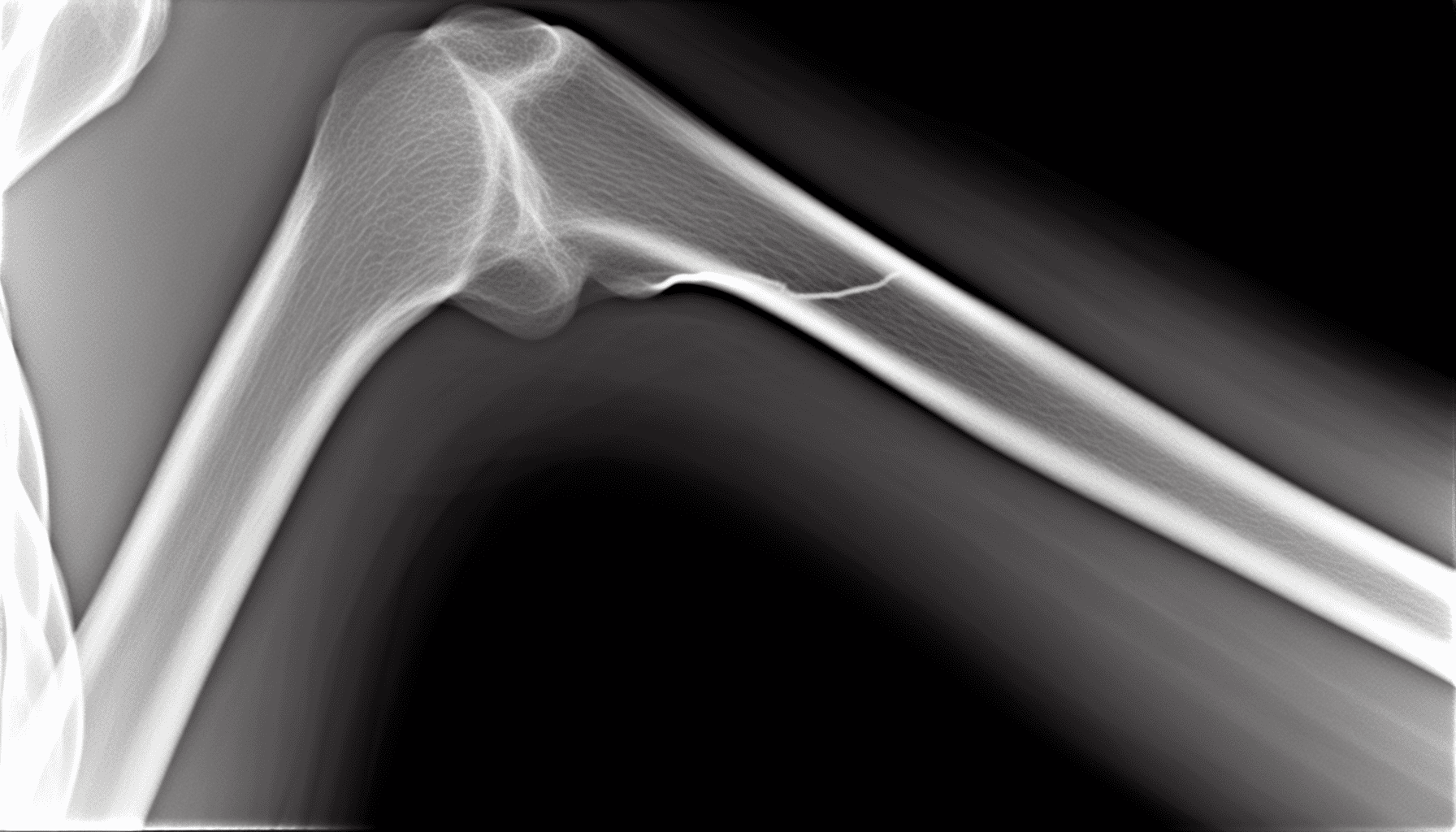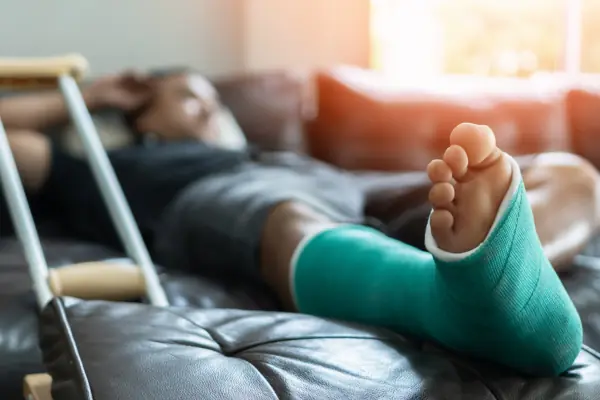Table of Contents
Estimating your compensation for a broken bone injury hinges on a range of impactful elements. From the extent of your injury and treatment costs to lost income and your own suffering, we dive into what shapes “how much is a broken bone injury case worth” to provide you with a grounded expectation.
Key Takeaways
- The compensation for broken bone injuries is determined by several factors such as the severity and location of the injury, medical expenses, lost wages, and pain and suffering experienced.
- Legal assistance, particularly from experienced personal injury lawyers, is critical for a broken bone injury claim to navigate the complexities of the legal system and counteract insurance company tactics.
- Documentation and evidence are essential in preparing a broken bone injury claim, including gathering medical records, photographic and video evidence, and following specific steps to maximize the claim’s strength.
Factors Influencing Broken Bone Compensation

Broken bone victims often find themselves swamped with medical bills, lost wages, and significant pain and suffering. The compensation for such injuries can be a financial lifesaver, but how much compensation can one expect? Several factors come into play here, each influencing the final settlement amount in different ways.
The factors that determine broken bone compensation include:
- The severity of the broken bone injury
- The location of the injury
- The medical treatment and expenses incurred
- Lost wages and future income
- The pain and suffering endured
We will now further examine these factors to gain a better understanding of their influence on the compensation amount.
Recovering from Broken Bones After a Car Accident?
Learn about treatment options and legal steps to take for broken bones sustained in a car accident.

Severity of the Injury
The severity of the broken bone injury is a significant factor impacting the compensation. More severe injuries typically result in higher compensation, given the increased medical costs and the profound impact on the victim’s life. For instance, a femur fracture, one of the most severe types of leg injuries, has a national average median verdict of $167,000, while broken legs have an estimated settlement value range between $55,000 and $150,000.
The type of fracture also matters. Displaced fractures, where the broken ends are out of alignment, and non-displaced fractures, where the bone remains aligned, are both determinants of severity and influence compensation.
Clearly, the settlement value of a broken bone injury claim is significantly influenced by the severity of the injury.
Location of the Injury

The location of the broken bone can result in different limitations and challenges during recovery, thus affecting the compensation amount. For example:
- A broken arm might result in fewer activity restrictions, compared to a leg fracture which may necessitate the use of crutches and severely limit mobility.
- Suffering broken ribs can severely restrict activities.
- A broken hip or pelvic bone may result in very limited mobility during the recovery period.
Moreover, breaking larger bones often leads to increased medical expenses and a higher risk of long-term complications, which could increase the compensation amount in a claim. Therefore, the location of the injury has a significant effect on the claim’s value.
Medical Treatment and Expenses
Medical treatment and expenses form a critical component of the compensation claim. The cost of treating a broken bone without insurance can widely vary from a few hundred dollars to over $10,000, influenced by factors such as the severity and complexity of the injury. Costs for non-surgical treatment start at approximately $2,500 for a broken arm or leg, while surgical treatment can skyrocket to a range of $16,000 to $35,000, depending on the specific injury.
Outpatient care commonly involves expenses for:
- casts
- blood tests
- x-rays
- medications
- minor surgeries
In contrast, inpatient care, often required for more severe fractures, is typically costlier. Also, physical therapy, which may be necessary for optimal recovery, can significantly add to the expenses, thus impacting the overall compensation amount for medical expenses.
Undoubtedly, the cost of medical treatment and related expenses are key determinants of the compensation for a broken bone injury.
Lost Wages and Future Income
Lost earnings until the point of settlement or court resolution, referred to as past lost income, are a component of economic damages and are more straightforward to prove than future lost earnings. However, proving future lost earnings requires the establishment of the injured party’s inability to work through expert testimony from medical and vocational rehabilitation professionals.
Lost wages included in a compensation claim cover immediate time missed and time for follow-up treatments, with the amount potentially influenced by employer policies and the specific industry’s return-to-work guidelines. The calculation of future lost earnings involves consideration of the injured person’s long-term medical prognosis and the impact on their work, along with the expected duration of their career and the concept of ‘present value’.
Therefore, lost wages and potential future income form a significant part of a broken bone injury claim.
Pain and Suffering
Compensation for broken bone injury claims can extend beyond tangible losses to include emotional pain and suffering. This non-economic damage is evaluated based on the impact of the injury on an individual’s life. For example, settlement for broken collarbones from car accidents may factor in pain and suffering in addition to compensation for medical treatment and lost wages.
Pain and suffering can include:
- Physical pain
- Emotional distress
- Loss of enjoyment of life
- Loss of consortium
These damages can significantly increase the total compensation amount, highlighting their critical role in broken bone injury claims.
Common Broken Bones in Accidents

Accidents can result in a plethora of bone fractures, including bone breaks, with each type affecting the compensation differently. Settlement compensation for broken bones is directly influenced by the type of bone fracture suffered, such as simple (closed), compound (open), comminuted, transverse, or hairline fractures. Common bones broken in car accidents include ribs, leg bones, clavicles, and arms, while slip and fall incidents frequently result in fractures to arms, elbows, faces, feet, legs, hands, fingers, knees, ribs, spinal vertebrae, skulls, tailbones, and wrists.
In car accidents, hip and facial fractures are particularly severe, leading to potential mobility loss and long-term disfigurement, respectively. Ankle fractures from slip and fall incidents can require surgery and may result in chronic pain or arthritis, and wrist fractures from both accidents can lead to reduced hand function or permanent range of motion loss. Therefore, the type of fracture is a crucial factor in determining the compensation.
Car Accident-Related Broken Bones
Car accidents can cause a range of bone fractures, with the mechanism of injury influencing the severity and complexity of the injury. Common bone fractures from car accidents include:
- Rib fractures from seatbelt pressure
- Clavicle fractures from the collision force against seatbelts
- Skull and facial bone fractures from airbag impact
- Limb fractures from the crash’s impact
Specific types of fractures such as femur fractures, which can occur due to bracing or vehicle crumpling, and pelvic fractures, often seen in motorcycle accidents, can be severe and have an important impact on the compensation amount. Thus, the kind of accident and the resulting fractures play a crucial role in determining the compensation for a broken bone claim.
Slip and Fall-Related Broken Bones
Slip and fall accidents can result from various hazards like:
- broken railings
- uneven flooring
- wet floors
- poor lighting
These accidents can lead to different types of bone fractures. The severity of these fractures and the resulting limitations can significantly influence the compensation amount. For instance, the average settlement payout range for fractured ribs due to slip and fall incidents is between $15,000 and $100,000.
Settlement amounts for fractured ribs can vary depending on the number of ribs fractured and the necessary medical treatment. Therefore, the type and severity of fractures resulting from slip and fall accidents have a profound effect on the compensation amount.
Real-Life Settlement Examples
Examining real-life settlement examples can provide valuable insight into the variability in compensation amounts for broken bone injury cases. Here are some average settlement values for different types of broken bones:
- Broken arm: $45,000 to $92,000
- Broken leg: $55,000 to $150,000
- Single vertebrae fracture: $112,000 (median national average)
- Multiple vertebrae fractures: $207,000 (median national average)
These numbers can give you an idea of what to expect in terms of compensation for your specific case. However, it’s important to note that every case is unique, and the actual settlement amount will depend on various factors.
Some notable high-value verdicts include $6 million for a 13-year-old student, $6 million for a 73-year-old man, and settlements of $3.9 million and $5.6 million for women injured in boating accidents. These examples highlight the considerable variability in compensation amounts for broken bone injury cases.
Car Accident Settlements
Car accident settlements involving broken bones can offer insights into the potential compensation outcomes for similar injury cases. For instance:
- The national median verdict for a single vertebra fracture case is $112,000
- Multiple vertebra fractures may lead to a median award of $207,000
- A femur fracture from a car accident typically results in a median national average verdict of \$167,000.
Moreover, the average settlement range for fractured ribs in car accidents is between \$15,000 and \$100,000, and broken arms from car accidents have an average settlement value range of \$45,000 to \$92,000. These examples illustrate the potential settlement amounts for car accident-related broken bones.
Slip and Fall Settlements
Slip and fall incidents can lead to serious injuries such as rib fractures, which may require substantial settlements. The average settlement payout range for fractured ribs due to slip and fall incidents is between $15,000 and $100,000. Settlement amounts for fractured ribs can vary depending on the number of ribs fractured and the necessary medical treatment.
These examples underscore the significant variability in settlement amounts for broken bone injury cases resulting from slip and fall incidents. They highlight the importance of understanding the potential compensation outcomes for similar injury cases.
Legal Assistance for Broken Bone Injury Claims

Having legal assistance, such as Scholle Law on your side, is indispensable for dealing with the complexities of broken bone injury claims and securing fair compensation. The quality of legal representation and a lawyer’s experience can significantly impact the compensation for a broken bone injury claim, as they influence insurance companies’ settlement calculations. An experienced personal injury lawyer can effectively establish liability, which is a critical step in pursuing a broken bone injury compensation claim.
Hiring a personal injury lawyer ensures professional assistance in navigating the complexities of the legal system and interacting with insurance companies. Therefore, choosing the right legal representation is crucial following a broken bone injury, with lawyers like those at NST Law providing tailored legal strategies.
Free Legal Consultation
At Scholle Law, we offer a ree legal consultation that can help people understand their legal options and potential for compensation after a broken bone injury. During the consultation, individuals can learn about the legal process, fault assessment, and receive answers to their questions without any financial commitment.
Clients should provide complete and truthful information during the consultation and be ready to trust the legal firm’s expertise in managing personal injury claims. Scheduling a free consultation with The Law Place is simple and provides an opportunity to engage with a dedicated legal team member.
No-Win-No-Fee Basis
No-win-no-fee arrangements, also known as contingency fee basis, ensure that clients only pay legal fees if their case is won, providing accessible legal representation regardless of individual financial situations.
No-win-no-fee arrangements offer the following benefits:
- Clients are not required to pay legal fees or associated costs unless they win their case.
- It reduces the financial risk for clients.
- It provides accessible legal representation for individuals who may not have the financial means to pay upfront legal fees.
In a no-win-no-fee case, law firms bear the financial risk and handle the variable factors that may affect the case’s likelihood of success as it progresses. Although no-win-no-fee services require payment of fees if the case is won, they differ from pro bono services, which are entirely free as an act of goodwill for those unable to afford legal access.
Preparing Your Claim: Documentation and Evidence
Preparing a successful broken bone injury claim requires correct and comprehensive documentation and evidence. Here are some key steps to follow:
- Gather medical records to document the timeline and cost of medical care.
- Use medical records to show the injury’s impact on the claimant’s life and prove it is not a pre-existing condition.
- Collect photographic and video evidence to establish the circumstances surrounding the accident and demonstrate liability in a personal injury claim.
Following these steps will help strengthen your broken bone injury claim.
Should an injured party be incapacitated, obtaining photographs as soon after the event as possible is advisable, even if immediate evidence capture isn’t feasible. An experienced attorney’s expertise in evidence collection is invaluable for substantiating the severity of injuries and combatting attempts by insurance companies to undermine the injuries’ legitimacy.
Navigating Insurance Company Tactics
Navigating personal injury cases and insurance company tactics requires skilled personal injury lawyers who can counteract attempts to deny or devalue claims. Insurance companies may call injury victims soon after an incident to catch them off guard and extract information that could be used against them, and they might request recorded statements to gather information that can later be used to deny or devalue claims.
Insurers may employ pressure tactics such as:
- making low settlement offers
- misrepresenting legal entitlements
- misleading claimants about the amount of insurance coverage available
- offering quick settlements with full release to prevent future claims
Skilled personal injury lawyers understand and can counteract these tactics by negotiating effectively for a fair settlement and advise against the insurance company’s suggestion of not hiring legal representation.
Summary
In conclusion, the journey towards claiming compensation for a broken bone injury can be complex and laden with intricate factors that influence the final settlement amount. Understanding these factors, having a skilled personal injury lawyer, and preparing your claim with solid evidence can significantly impact the compensation outcome. We hope this guide has provided you with valuable insights into the intricacies of broken bone injury compensation claims, empowering you to navigate your journey with confidence.
Frequently Asked Questions
Does a broken bone count as a serious injury?
Yes, a broken bone can be considered a serious injury if it causes long-term consequences such as being unable to walk for an extended period of time.
What is the average payout for a broken leg?
The average payout for a broken leg varies depending on the specific bone and severity, but generally ranges from \$70,000 to \$175,000 in a personal injury lawsuit. This compensation accounts for the different types of leg fractures.
How much is a broken elbow worth in a lawsuit?
In a lawsuit, the average settlement amount for a broken elbow is estimated to be between $50,000 and $150,000, depending on the severity of the injury.
How does the severity of the injury affect the compensation amount?
The severity of the injury directly affects the compensation amount, as more severe injuries lead to higher compensation due to increased medical costs and impact on the victim’s life.
What is the role of medical treatment and expenses in determining the compensation amount?
The cost of medical treatment and expenses directly influences the compensation amount, as it forms a significant portion of the economic damages in a compensation claim. Therefore, it is crucial to keep track of all medical costs and expenses related to the injury.
